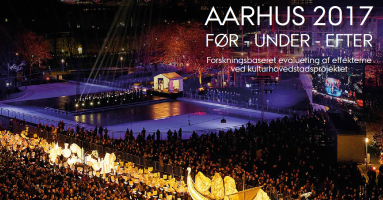– The evaluation of Aarhus as European Capital of Culture 2017
Evaluating cultural events is always challenging. But evaluating the impact of an entire year of cultural initiatives, performances, shows etc. can seem almost impossible. Nevertheless this is what the new report RethinkIMPACTS2017 aims to do, and therefore it is profoundly interesting for The Suitcase, and it is what we are ‘reading right now’.

Foto: Jan Kejser
The City of Aarhus was European Capital of Culture in 2017. Under the theme Rethink, Aarhus and 18 other municipalities in the Region of Central Denmark worked to develop and present a varied cultural program. This in itself is interesting and impressive, but for the Suitcase, the art of evaluating an enormous project like this is just as impressive.
The data collection and data analysis was carried out by a number of people, primarily from Aarhus University, and led by Associate Professors Hans-Peter Degn and Louise Ejgod Hansen.
The evaluation is very comprehensive, based on 5 years of data collection and analysis of interviews, surveys, document analysis etc. The report contains interesting reflections and results. However, if you are short on time, I would encourage you to jump straight to chapter 7, in which the authors reflect on and rethink their own methods. Here it becomes clear that many insights arising from a project of this size are applicable for and recognizable to small projects like The Suitcase of Methods as well.
The aim with the evaluation of Aarhus2017 was to work transdisciplinary and to develop new evaluation methods. The transdisciplinary approach worked well, but according to the evaluation, it was challenging to find time and money to support the development of new methods. The data therefore, is primarily collected though well known and tested methods. A project of this size would have benefitted from automatic, technological data collection for instance through an app. The self-evaluation thus points at an interesting and very typical dilemma: The need for new evaluation methods within the field of culture experiences and (in contrast) the obligation for accurate and well-established evaluations. In the Suitcase, we have seen how the methods we use affect our results as we have been privileged enough to have time to try out and experiment with different methods (however on a smaller scale, You can read our results our reports here) But cultural organizations are rarely in a situation where they are willing or able to potentially compromise the quality of the results in order to test a new method. Thus, if a large project such as Aarhus2017 should contain methodological innovation, it needs to be prioritized in terms of time, economy but also when it comes to the hours researchers will have to put into it.
On a different note, it was refreshing to see a very transparent and honest self-evaluation that seemed genuinely interested in communicating results but also leaning from the process of planning, carrying out and evaluating this project.
A side from these methodological reflections, the report also emphasize the importance of the support from and collaboration between various municipalities as well as between the involved institutions, companies and individuals. Furthermore, it was interesting to learn that politicians, officials, and sponsors have become more aware of the value of culture, as a result of this large event. However, this has not resulted in an increased economic support for cultural projects, which also is thought provoking.
 From the Royal Danish Theatre’s own perspective, the project Aarhus2017 gave us the possibility to collaborate with Moesgaard Museum and use their beautiful venue as location for our staging of Røde Orm. This gave us the opportunity to reach a greater audience than usual from Jutland.
From the Royal Danish Theatre’s own perspective, the project Aarhus2017 gave us the possibility to collaborate with Moesgaard Museum and use their beautiful venue as location for our staging of Røde Orm. This gave us the opportunity to reach a greater audience than usual from Jutland.
Read the entire report (the report is in Danish), and find more information about the different project of Aarhus2017 here.











 Remember the pulsating heart? We are ready with report #13 that sums up our reflections and learnings from the project ‘Connecting through pulse’. Read how the combination of hand blown glass, digital technology and live performance art give rise to reflections about the connection between the audience in the auditorium and the artists on stage.
Remember the pulsating heart? We are ready with report #13 that sums up our reflections and learnings from the project ‘Connecting through pulse’. Read how the combination of hand blown glass, digital technology and live performance art give rise to reflections about the connection between the audience in the auditorium and the artists on stage.